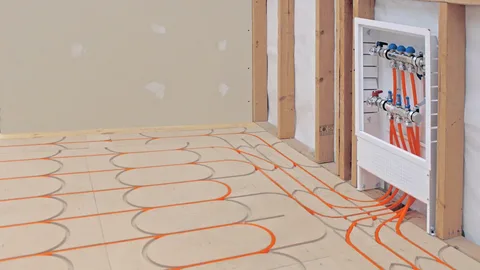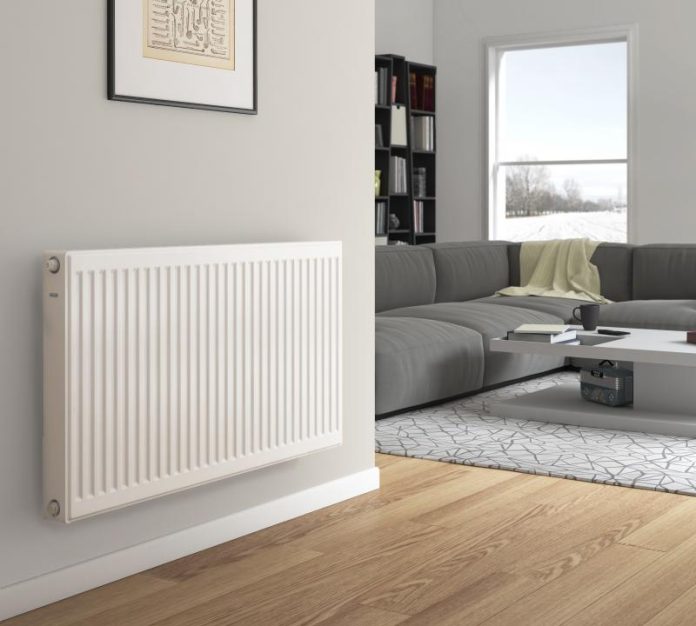When it comes to heating your home, there are many options to choose from. One option that is gaining popularity for its efficiency and comfort is Hydronic Radiant-Heat. This type of heating system uses hot water to warm the floors and radiate heat throughout the room. Not only does it provide a more even distribution of heat, but it also eliminates the need for bulky and unsightly radiators or vents. In this blog post, we will delve into the world of Hydronic Radiant-Heat and explore its benefits, costs, and installation process. Whether you’re looking to upgrade your heating system or build a new home, this guide will provide you with all the information you need to know about Hydronic Radiant Heat.
Understanding the Basics of Hydronic Radiant-Heat
Hydronic Radiant-Heat may sound like a complex concept, but at its core, it’s a simple and efficient way to heat your home. Understanding the basics of Hydronic Radiant-Heat will help you appreciate its benefits and make an informed decision for your heating needs.
At its most fundamental level, Hydronic Radiant-Heat uses hot water to warm the floors of your home. This heated water is circulated through a network of pipes installed beneath the floor surface, providing consistent and comfortable warmth throughout the space. Unlike traditional heating systems that rely on forced air, Hydronic Radiant-Heat delivers heat directly to the floor, resulting in more even and comfortable heat distribution.
In addition to its superior comfort, Hydronic Radiant-Heat also eliminates the need for bulky radiators or vents. With this system, you can enjoy a clean and uncluttered living space, free from obstructive heating elements.
To control the temperature, most hydronic radiant-heat systems are equipped with individual room thermostats, allowing you to customize the comfort level in each area of your home. This zoning capability not only enhances comfort but also helps to conserve energy by only heating the rooms that are in use.
The Benefits and Installation Process of Hydronic Heating Panels
Hydronic heating panels offer numerous benefits and a straightforward installation process. One of the key advantages of these panels is their ability to provide consistent and comfortable heat throughout your home; unlike traditional heating systems, which can lead to uneven temperature distribution, hydronic heating panels deliver warmth evenly across the floor surface, resulting in a cozy and inviting environment.
Another benefit of hydronic heating panels is their aesthetic appeal. These panels are discreetly installed beneath the floor, eliminating the need for bulky radiators or vents that can detract from the overall design of your space. It creates a clean and uncluttered living area, allowing you to enjoy your home without any obstructions fully.
The installation process for hydronic heating panels is relatively simple. First, the pipes or tubes that carry the heated water are installed beneath the flooring material. It can be done during the construction phase of a new home or as a retrofit for an existing space. Once the pipes are in place, a layer of insulation is added to ensure optimal heat transfer. Finally, the flooring material of your choice is installed over the top, creating a seamless and comfortable surface.
Factors Affect Hydronic Heating Panels Price
When it comes to considering hydronic heating panels for your home, understanding the factors that affect their price is crucial. This knowledge will help you make an informed decision and budget accordingly.
One of the primary factors that influence the Hydronic Heating Panels Price is the size of the area you want to heat. The larger the space, the more panels you will need, which will increase the overall cost. Additionally, the complexity of the installation can affect the price. If your home requires extensive modifications or if the layout is challenging, it may require more time and labor, which can drive up the cost.
The type of flooring material you choose is another important factor. Different materials have different installation requirements, and some may require additional preparation or insulation, which can impact the price. Additionally, the type of hydronic heating system you opt for, such as electric or gas-powered, will also affect the cost.
Exploring the Efficiency of Hydronic Heating Panels For Sale
As you consider upgrading your heating system, it’s essential to explore the efficiency of Hydronic Heating Panels For Sale. One of the primary advantages of Hydronic Radiant-Heat is its ability to provide efficient and even heat distribution throughout your home. It means you can enjoy a warm and cozy environment without wasting energy.
When it comes to the efficiency of hydronic heating panels, several factors come into play. First and foremost, the quality of the panels themselves is crucial. Higher-quality panels are designed to maximize heat transfer and minimize energy loss, resulting in improved efficiency. It’s worth investing in top-of-the-line panels that offer better insulation and durability, as they will pay off in the long run.
Additionally, the insulation of your home plays a significant role in the efficiency of hydronic heating panels. Proper insulation helps retain the heat generated by the panels, preventing energy waste and ensuring a more efficient heating system.
 Exploring Warm Floors Radiant Heating and Its Efficiency
Exploring Warm Floors Radiant Heating and Its Efficiency
Warm floor radiant heating is a highly efficient and comfortable heating option that provides consistent warmth throughout your home. This innovative heating system works by using hot water to warm the floors, creating a cozy and inviting atmosphere in every room.
One of the main advantages of warm floor radiant heating is its energy efficiency. Because the heat is distributed through the floor, it radiates upward, ensuring that the warmth is evenly spread throughout the space. It means that you can enjoy a comfortable temperature without the need to constantly adjust your thermostat, saving energy and reducing heating costs.
Additionally, Warm Floors Radiant Heating eliminates the need for bulky radiators or vents, allowing for a clean and uncluttered living area. The absence of these heating elements not only enhances the aesthetics of your home but also provides more freedom in furniture placement.
Furthermore, warm-floors radiant heating can improve indoor air quality. Unlike forced air systems, which can circulate dust and allergens, radiant heat does not blow air, minimizing the spread of airborne particles. It can be particularly beneficial for individuals with allergies or respiratory issues.
In terms of efficiency, warm-floors radiant heating offers quick and responsive heat. Once the system is turned on, the floor surface heats up rapidly, providing instant warmth. This responsiveness ensures that you can quickly adjust the temperature to your desired level.
Common Issues with Hydronic Radiant-Heat and How to Fix Them
Hydronic radiant-heat systems are generally reliable and low-maintenance. However, like any heating system, they can experience occasional issues. Understanding these common issues and how to fix them can help ensure your hydronic radiant-heat system operates smoothly and efficiently.
One common issue is uneven heat distribution. If you notice that some areas of your home are warmer than others, it may be due to air bubbles or debris in the pipes. To fix this, you can bleed the system by opening the bleed valves and allowing any trapped air to escape. It’s also important to regularly flush the system to remove any debris or sediment that may accumulate over time.
Another issue that may arise is leaks. If you notice water pooling or damp spots on your floors, it’s crucial to address the leak immediately. Start by identifying the source of the leak, which could be a faulty pipe connection or a damaged pipe. Repair or replace the affected components as necessary and check for any additional leaks throughout the system.
A common problem with hydronic radiant-heat systems is fluctuating water temperatures. Issues with the boiler or the control valves can cause this. Inspect the boiler for any signs of malfunction or damage, such as a faulty thermostat or a malfunctioning pressure relief valve. If the control valves are not functioning properly, they may need to be adjusted or replaced.
Essential Tips for Choosing and Installing Hydronic Radiant Floor Heating Panels
Choosing and installing hydronic radiant floor heating-panels requires careful consideration and planning to ensure optimal performance and efficiency. Here are some essential tips to guide you through the process:
- Determine your heating needs: Before selecting hydronic radiant floor heating-panels, assess your heating requirements. Consider factors such as the size of the space, the insulation level, and the desired temperature range. This information will help you choose the appropriate panel size and system capacity.
- Select the suitable panel material: Hydronic Radiant Floor Heating Panels are available in various materials, including aluminium, copper, and PEX (cross-linked polyethylene). Each material has different heat transfer properties and installation requirements. Research the pros and cons of each material and choose the one that best suits your needs and budget.
- Hire a professional installer: Installing hydronic radiant floor heating-panels requires specialized knowledge and skills. It is crucial to hire a professional installer who is experienced in hydronic heating systems. They will ensure proper placement and connection of the panels, avoiding potential issues in the future.
- Consider zoning: Zoning allows you to control the temperature in different areas of your home independently. This feature is handy for larger homes or areas with varying heating requirements. Please consult with your installer to determine the number of zones needed and how to optimize their effectiveness.
- Regular maintenance: To maintain the efficiency and longevity of your hydronicradiant floor heating system, it is essential to perform regular maintenance. It includes flushing the system periodically to remove any debris or sediment buildup, inspecting the pipes for leaks, and ensuring the proper functioning of the control valves.
FAQs
Q: How does Hydronic Radiant-Heat work?
A: Hydronic Radiant-Heat works by using hot water to warm the floors of your home. This heated water is circulated through a network of pipes installed beneath the floor surface, providing consistent and comfortable warmth throughout the space.
Q: Is Hydronic Radiant-Heat energy-efficient?
A: Yes, Hydronic Radiant-Heat is highly energy-efficient. Because the heat is distributed through the floor, it radiates upward, ensuring that the warmth is evenly spread throughout the space. It means that you can enjoy a comfortable temperature without wasting energy. Additionally, the insulation of your home plays a significant role in the efficiency of Hydronic Radiant-Heat.
Q: Are hydronic heating panels suitable for both new construction and retrofit projects?
A: Yes, hydronic heating panels are suitable for both new construction and retrofit projects. During the construction phase of a new home, the pipes or tubes that carry the heated water can be installed beneath the flooring material.
Q: How do I choose the right Hydronic Radiant Heat for my home?
A: When choosing hydronic heating panels for your home, consider factors such as the size of the space, the insulation level, and your desired temperature range. This information will help you choose the appropriate panel size and system capacity. It’s also essential to research the different materials available, such as aluminium, copper, and PEX, and choose the one that best suits your needs and budget.
Conclusion
Hydronic Radiant-Heat is an efficient and comfortable heating option for your home. By using hot water to warm the floors, this system provides even heat distribution and eliminates the need for bulky radiators or vents. Hydronic heating panels offer numerous benefits and can be easily installed. Factors such as the size of the area, installation complexity, and choice of flooring material can affect the price. By investing in high-quality panels and ensuring proper insulation, you can maximize the efficiency of your hydronic radiant-heat system. With its energy efficiency and cozy warmth, Hydronic Radiant-Heat is a great choice for upgrading your heating system.

